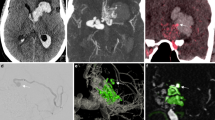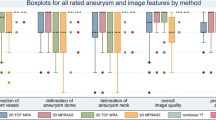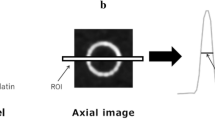Abstract
Purpose
Complex neurovascular lesions in children require precise anatomic understanding for treatment planning. Although 3DRA is commonly employed for volumetric reformation in neurointerventional procedures, the ability to reconstruct this data into CT-like images (3DRA-CT) is not widely utilized. This study demonstrates the feasibility and usefulness of 3DRA-CT and subsequent MRI fusion for problem solving in pediatric neuroangiography.
Methods
This retrospective study includes 18 3DRA-CT studies in 16 children (age 9.6 ± 3.8 years, range 2–16 years) over 1 year. After biplane 2D-digital subtraction angiography (DSA), 5-second 3DRA was performed with selective vessel injection either with or without subtraction. Images were reconstructed into CT sections which were post-processed to generate multiplanar reformation (MPR) and maximum intensity projection (MIP) images. Fusion was performed with 3D T1 MRI images to precisely demonstrate neurovascular relationships. Quantitative radiation metrics were extracted and compared against those for the entire examination and for corresponding biplane 2D-DSA acquisitions.
Results
In all 18 cases, the 3DRA procedure and MRI fusion were technically successful and provided clinically useful information relevant to management. The unsubtracted and subtracted 3DRA acquisitions were measured to deliver 5.9 and 132.2%, respectively, of the mean radiation dose of corresponding biplane 2D-DSA acquisitions and contributed 1.2 and 12.5%, respectively, to the total procedure dose.
Conclusion
Lower radiation doses, high spatial resolution, and multiplanar reformatting capability make 3DRA-CT a useful adjunct to evaluate neurovascular lesions in children. Fusing 3DRA-CT data with MRI is an additional capability that can further enhance diagnostic information.






Similar content being viewed by others
References
Honarmand AR, Gemmete JJ, Hurley MC, Shaibani A, Chaudhary N, Pandey AS et al (2015) Adjunctive value of intra-arterial cone beam CT angiography relative to DSA in the evaluation of cranial and spinal arteriovenous fistulas. J Neuro Interventional Surg 7(7):517–523
Safain MG, Rahal JP, Patel S, Lauric A, Feldmann E, Malek AM (2014) Superior performance of cone-beam CT angiography in characterization of intracranial atherosclerosis. J Neurosurg 121(2):441–449
Eesa M, Sharma P, Mitha AP, Sutherland GR, Goyal M (2009) Angiographic computed tomography with selective microcatheterization in delineating surgical anatomy in the case of a dural arteriovenous fistula. Technical note J Neurosurg 111(5):916–918
Schulz CJ, Schmitt M, Böckler D, Geisbüsch P (2016) Intraoperative contrast-enhanced cone beam computed tomography to assess technical success during endovascular aneurysm repair. J Vasc Surg 64(3):577–584
Patel NV, Gounis MJ, Wakhloo AK, Noordhoek N, Blijd J, Babic D et al (2011) Contrast-enhanced angiographic cone-beam CT of cerebrovascular stents: experimental optimization and clinical application. AJNR Am J Neuroradiol 32(1):137–144
Clarençon F, Piotin M, Pistocchi S, Babic D, Blanc R (2012) Evaluation of stent visibility by flat panel detector CT in patients treated for intracranial aneurysms. Neuroradiology 54(10):1121–1125
Heran NS, Song JK, Namba K, Smith W, Niimi Y, Berenstein A (2006) The utility of Dyna CT in neuroendovascular procedures. Am J Neuroradiol 27(2):330–332
Shinohara Y, Sakamoto M, Takeuchi H, Uno T, Watanabe T, Kaminou T et al (2013) Subarachnoid hyperattenuation on flat panel detector-based conebeam CT immediately after uneventful coil embolization of unruptured intracranial aneurysms. AJNR Am J Neuroradiol 34(3):577–582
Orth RC, Wallace MJ, Kuo MD (2009) C-arm cone-beam CT: general principles and technical considerations for use in interventional radiology. J Vasc Interv Radiol 20(7):S538–S544
Bai M, Liu B, Mu H, Liu X, Jiang Y (2012) The comparison of radiation dose between C-arm flat-detector CT (Dyna CT) and multi-slice CT (MSCT): a phantom study. Eur J Radiol 81(11):3577–3580
van Rooij WJ, Sprengers ME, de Gast AN, Peluso JPP, Sluzewski M (2008) 3D rotational angiography: the new gold standard in the detection of additional intracranial aneurysms. Am J Neuroradiol 29(5):976–979
Bechan RS, van Rooij SB, Sprengers ME, Peluso JP, Sluzewski M, Majoie CB et al (2015) CT angiography versus 3D rotational angiography in patients with subarachnoid hemorrhage. Neuroradiology 57(12):1239–1246
Shi W-Y, Li Y-D, Li M-H, Gu B-X, Chen S-W, Wang W et al (2010) 3D rotational angiography with volume rendering: the utility in the detection of intracranial aneurysms. Neurol India 58(6):908–913
Ruijters D, Homan R, Mielekamp P, van de Haar P, Babic D (2011) Validation of 3D multimodality roadmapping in interventional neuroradiology. Phys Med Biol 56(16):5335–5354
Hiu T, Kitagawa N, Morikawa M, Hayashi K, Horie N, Morofuji Y et al (2009) Efficacy of Dyna CT digital angiography in the detection of the fistulous point of dural arteriovenous fistulas. Am J Neuroradiol 30(3):487–491
Kakeda S, Korogi Y, Miyaguni Y, Moriya J, Ohnari N, Oda N et al (2007) A cone-beam volume CT using a 3D angiography system with a flat panel detector of direct conversion type: usefulness for superselective intra-arterial chemotherapy for head and neck tumors. Am J Neuroradiol 28(9):1783–1788
Nagarajappa AK, Dwivedi N, Tiwari R (2015) Artifacts: the downturn of CBCT image. J Int Soc Prev Community Dent 5(6):440–445
Aadland TD, Thielen KR, Kaufmann TJ, Morris JM, Lanzino G, Kallmes DF et al (2010) 3D C—arm conebeam CT angiography as an adjunct in the precise anatomic characterization of spinal dural arteriovenous fistulas. Am J Neuroradiol 31(3):476–480
Wang C, Nguyen G, Toncheva G, Jiang X, Ferrell A, Smith T et al (2014) Evaluation of patient effective dose of neurovascular imaging protocols for C-arm cone-beam CT. AJR Am J Roentgenol 202(5):1072–1077
Seguchi S, Saijou T, Ishikawa Y, Koyama S (2014) Radiation dose evaluation in 3D rotation angiography and cone-beam computed tomography with a flat panel detector. Nihon Hōshasen Gijutsu Gakkai Zasshi 70(7):646–652
Guberina N, Lechel U, Forsting M, Mönninghoff C, Dietrich U, Ringelstein A (2016) Dose comparison of classical 2-plane DSA and 3D rotational angiography for the assessment of intracranial aneurysms. Neuroradiology 12
Abe T, Hirohata M, Tanaka N, Uchiyama Y, Kojima K, Fujimoto K et al (2002) Clinical benefits of rotational 3D angiography in endovascular treatment of ruptured cerebral aneurysm. AJNR Am J Neuroradiol 23(4):686–688
Author information
Authors and Affiliations
Corresponding author
Ethics declarations
Funding
No funding was received for this study.
Conflict of interest
The authors declare that they have no conflict of interest.
Ethical approval
All procedures performed in the studies involving human participants were in accordance with the ethical standards of the institutional Research Ethics Board (REB) with REB#1000 055502 and with the 1964 Helsinki Declaration and its later amendments or comparable ethical standards. For this type of study formal consent is not required.
Informed consent
Informed consent was obtained from all individual participants included in the study.
Rights and permissions
About this article
Cite this article
Muthusami, P., Shkumat, N., Rea, V. et al. CT reconstruction and MRI fusion of 3D rotational angiography in the evaluation of pediatric cerebrovascular lesions. Neuroradiology 59, 625–633 (2017). https://doi.org/10.1007/s00234-017-1818-y
Received:
Accepted:
Published:
Issue Date:
DOI: https://doi.org/10.1007/s00234-017-1818-y




